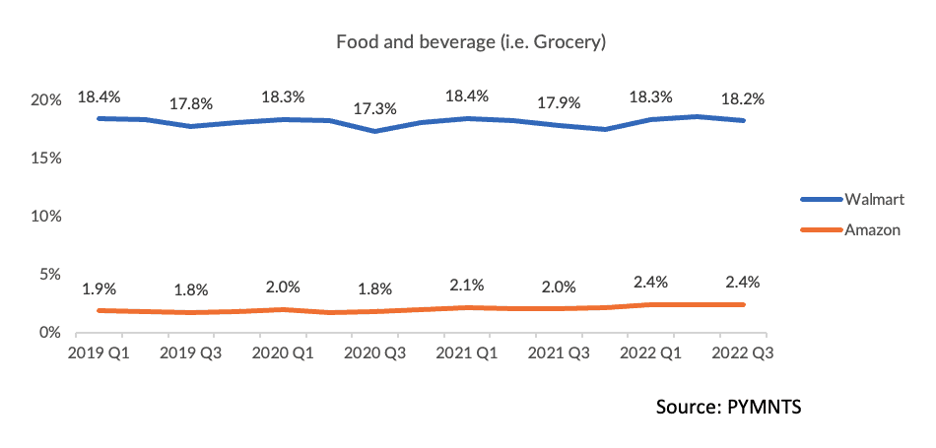
Walmart may be well ahead of Amazon in terms of share of the total grocery market, but when it comes to the center aisles, the latter is pulling ahead.
According to PYMNTS data, Walmart’s share of the total food and beverage market is about seven times that of Amazon. Yet, when it comes to shelf-stable items, while Amazon is touting major gains, Walmart is feeling the pressure of rising costs and shrinking margins.
On the retail giant’s earnings call earlier this month, CEO Doug McMillon laid out the issue to analysts.
“In the dry grocery and consumables categories like paper goods, we continue to see high single-digit to low double-digit cost inflation. We all need those prices to come down,” McMillon said. “The persistently high rates of inflation in these categories lasting for such a long period of time are weighing on some of the families we serve. … This stubborn inflation in dry grocery and consumables is one of the key factors creating uncertainty for us in the back half of the year because of the cumulative impact on discretionary spending and other categories.”

Meanwhile, Amazon has been holding up these categories as a bright spot in its grocery business, with its wide selection relative to brick-and-mortar grocers presenting a competitive advantage for those seeking variety and with its popular Subscribe & Save program enabling the eCommerce giant to win the loyalty of deal seekers.
Amazon CEO Andy Jassy spoke to this strength on an earnings call last month.
“We have actually quite a large grocery business,” Jassy said. “It’s just an unusual … grocery business, very much like how the mass merchandisers got into grocery 25, 30 years ago, where the selection are items that are not temperature controlled. … In this current environment where consumers are being cautious about what they spend and finding ways to trade down in different product variations, consumables have stayed very, very strong.”

Certainly, Amazon is keeping consumers engaged. A PYMNTS survey of nearly 2,700 U.S. consumers conducted last month reveals that 61% of U.S. consumers are Amazon Prime members, and 26% are subscribed to Walmart+.
Plus, consumers are indeed turning to eCommerce channels to get items that they would have once purchased at the supermarket. Research from PYMNTS’ study “Changes in Grocery Shopping Habits and Perception,” which drew from a December survey of more than 2,400 U.S. consumers, found that the majority of grocery shoppers continue to get fresh, perishable foods such as fruits and vegetables as well as meat, chicken and fish in stores.
Yet, when it comes to shelf-stable items, there has been a shift. The study revealed that only 35% of consumers are purchasing the majority of their healthcare products and cleaning supplies in stores, and only 33% said the same of personal care and health items.
As such, Walmart may be directing investors’ focus to the margin challenges presented by the current inflationary environment, but the bigger threat to the mega-retailer’s center-aisle business may come from Amazon’s rise to prominence in the space.